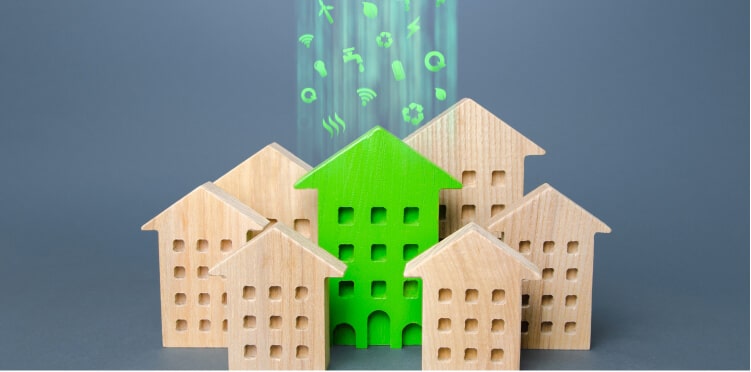Hyundai Motorstudio Senayan Park
Hyundai Motorstudio Senayan Park
Newsroom
The official news from Hyundai Motorstudio Senayan Park and a collection of innovative articles on mobility and sustainability here.
-
Green Building Concept and Its Implementation
- Hyundai Motorstudio Senayan Park Senayan Park 2022.08.17
-
Many think that green buildings are only made by adding vines to the walls or solar panels. The green building concept is more than that!
As an illustration, 90% of electricity is spent to supply buildings and houses. By applying the concept of green building, electricity consumption can be reduced by up to 50%. That is why, green building plays a key role in fighting climate change.
Green building minimizes the use of energy and water resources. Through its various benefits, green building is now increasingly popular in modern buildings.
What is the Green Building Concept?
Green building is more than just a building made using eco-friendly materials. The green building concept is based on environmental aspects by applying the principles of sustainable environment.
Its main goal is to minimize negative impacts on the environment and maximize positive impacts on humans as its inhabitants. A comprehensive plan is needed to implement green building, from design, construction, operation, and maintenance.
The goal is to increase building efficiency by integrating the latest technology to provide energy needs and build a healthy environment. Aspects that are prioritized in green building include energy efficiency and natural resources.
Energy consumption should be kept to a minimum to reduce the greenhouse effect. Green building should be a building that allows its residents to preserve the nature surroundings without losing its main benefits as a building.
The construction process and during operation must reflect healthy practices to avoid interfering the soil, water, and other resources around. The concept of green building is more necessary because it can reduce global warming, maintain natural resource reserves, and improve human health.
Application of the Green Building Concept
The building sector accounts for more than a third of the global greenhouse effect. This number will increase in the future, if there is no intervention to the building model that is currently developing.
Green building combines the best approaches such as materials, technology, and practices in all aspects. This approach ensures the building doesn’t have a negative impact on humans and the environment.
Its implementation is by using renewable energy in all aspects, such as innovative materials that do not depend on natural resources. Maximizing the use of renewable energy is the main focus.
Solar panels are one of the most widely adopted practices from a technological aspect. From a design aspect, the building can be positioned according to local conditions in order to maximize the air circulation and the natural light. In this case, the orientation of the window should be considered.
Plants have been the main characteristics of the green building concept. Some modern buildings even use green roofs to manage rainwater, create insulation, and cool the surrounding air.
Adding a garden can maximize water absorption while improving environmental conditions around the residence.
Advantages of Green Building
The benefits of green building vary widely, from environmental to economic and social. By adopting this concept, humans can benefit from the nature. Some of the advantages of green building include:
1. Saving Water
The ideal green building concept is able to reduce water consumption by up to 30% compared to conventional buildings. Count more, eco-friendly buildings can reduce the greenhouse effect by 62%.
The energy required for housing is 50% lower in one year. That means, the production of carbon emissions from household activities will drop dramatically.
2. Preserving Natural Resources
The majority of houses are currently only for a place to live, by applying the concept of green building, houses can offer more functions as nature reserves.
The building sector has great potential in reducing emissions compared to other sectors that produce large amounts of carbon emissions. There are 84 gigatons of carbon dioxide emissions that can be prevented by 2050.
This occurs because green buildings are very efficient in energy use, even the energy is in the form of renewable energy. As a result, the global temperature will drop up to 2 C.
3. Improve Air and Water Quality
Research explains that good air quality, with low carbon pollution, and ideal air ventilation can improve oxygen concentrations by up to 8%.
Green building helps the ecosystem because it uses renewable energy, reduces pollution, and requires residents to adopt a zero waste lifestyle, using non-toxic and eco-friendly products.
The environment should be a focus in the design, construction, operation, and allow buildings to be adapted to suit changing environments.
4. Increasing Selling Prices
The green building concept offers cheaper construction costs, while the selling price will be more expensive. Whether the building is new or old, there is a 7% increase in price compared to conventional buildings. For developers, green building clearly promises high profit margins.
5. Increasing Productivity
The focus of green building is not only limited to the environment, but to its residents. Besides being eco-friendly, green building is able to increase productivity, health, and happiness.
This positive benefit is obtained because the operational costs of the building are very low so, psychologically, the occupants will not be burdened with any bills.
Study showed that individuals who worked in an open space with ideal ventilation experienced a 101% increase in cognitive brain function. Meanwhile, workers in offices with small windows only have about 46 minutes of productive time in total.




